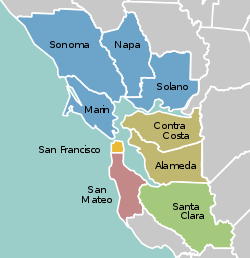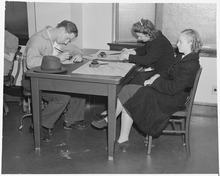Portal:San Francisco Bay Area
The San Francisco Bay Area Portal  The San Francisco Bay Area (referred to locally as the Bay Area) is a populous region surrounding the San Francisco and San Pablo estuaries in Northern California. The region encompasses the major cities and metropolitan areas of San Jose, San Francisco, and Oakland, along with smaller urban and rural areas. The Bay Area's nine counties are Alameda, Contra Costa, Marin, Napa, San Francisco, San Mateo, Santa Clara, Solano, and Sonoma. Home to approximately 7.68 million people, the nine-county Bay Area contains many cities, towns, airports, and associated regional, state, and national parks, connected by a network of roads, highways, railroads, bridges, tunnels, and commuter rail. The combined statistical area of the region is the second-largest in California (after the Greater Los Angeles area), the fifth-largest in the United States, and the 43rd-largest urban area in the world with 8.80 million people. The Bay Area has the second-most Fortune 500 companies in the United States, after the New York metropolitan area, and is known for its natural beauty, liberal politics, entrepreneurship, and diversity. The area ranks second in highest density of college graduates, after the Washington, D.C. metropolitan area and performs above the state median household income in the 2010 census; it includes the five highest California counties by per capita income and two of the top 25 wealthiest counties in the United States. Based on a 2013 population report from the California Department of Finance, the Bay Area is the only region in California where the rate of people migrating in from other areas in the United States is greater than the rate of those leaving the region, led by Alameda and Contra Costa counties. (more...) Selected article In the late 1960s, few professional football games took longer than two and a half hours to play, and the Jets–Raiders three-hour television time slot was thought to be adequate. However, in this instance, a high-scoring contest between the two bitter American Football League rivals, together with a number of injuries and penalties, caused the game to run long. Although NBC executives had originally ordered that Heidi must begin on time, as 7 p.m. approached, and it became clear the exciting game would run long, they decided to postpone the start of the film and continue football coverage. However, when they tried to call the studio to implement their decision, they were unable to get through because so many members of the public were calling NBC to inquire, complain, or opine about the scheduled 7 p.m. cutoff that the NBC switchboards were jammed. As a result, the change could not be communicated, and Heidi began as scheduled, preempting the final moments of the game in the eastern part of the country—to the outrage of viewers there, who missed two Oakland touchdowns that turned the game around. The Heidi Game led to a change in the way professional football is shown on network television; ever since then, games have been shown to their conclusion before evening programming begins. The experience also led television networks to take steps to ensure that network personnel would be able to communicate with each other under similar circumstances in the future: special telephones (dubbed "Heidi phones") were installed that connected through a separate telephone exchange. In 1997, the Heidi Game was voted the most memorable regular season game in U.S. professional football history. (more...) Selected biography William Randolph Hearst (April 29, 1863 – August 14, 1951) was an American newspaper publisher who built the nation's largest newspaper chain and whose methods profoundly influenced the history of American journalism. Hearst entered the publishing business in 1887 after being given control of The San Francisco Examiner by his wealthy father. Moving to New York City, he acquired The New York Journal and engaged in a bitter circulation war with Joseph Pulitzer's New York World that led to the creation of yellow journalism—sensationalized stories featuring crime, corruption, sensation and sex, and of sometimes dubious veracity. Acquiring more newspapers, Hearst created a chain that numbered nearly 30 papers in major American cities at its peak. He later expanded to magazines, creating the largest newspaper and magazine business in the world. He was twice elected as a Democrat to the U.S. House of Representatives, and ran unsuccessfully for Mayor of New York City in 1905 and 1909, for Governor of New York in 1906. Politically he was on the left wing of the Progressive Movement, speaking on behalf of the working class. He controlled the editorial positions and coverage of political news in all his papers and magazines and thereby exercised enormous political influence. He called for war in 1898 against Spain—as did many papers—but he did it in sensational fashion. After 1918 he called for an isolationist foreign policy to avoid any more entanglement in corrupt European affairs. He was at once a militant nationalist, a fierce anti-communist, and deeply suspicious of the League of Nations and of the British, French, Japanese, and Russians. He was a leading supporter of Franklin Roosevelt in 1932-34, but then broke with FDR and became his most prominent enemy on the right. His peak circulation reached 20 million readers a day in the mid 1930s, but he was a bad money manager and was so deeply in debt that most of his assets had to be liquidated in the late 1930s; but he kept his newspapers and magazines. His life story was the main inspiration for the ridicule of the lead character in Orson Welles's film Citizen Kane. His famous mansion, Hearst Castle, on a hill overlooking the Pacific Ocean near San Simeon, is now a State Historical Monument and a National Historic Landmark. (more...) Selected city The city is one of the major cities that make up the Silicon Valley located in the San Francisco Bay Area. It is the seventh most populous city in the San Francisco Bay Area. Sunnyvale is bordered by portions of San Jose to the north, Moffett Federal Airfield to the northwest, Mountain View to the west, Los Altos to the southwest, Cupertino to the south, and Santa Clara to the east. It lies along the historic El Camino Real and Highway 101. As part of the Silicon Valley, high-tech companies such as Juniper Networks, Fortinet, AMD, NetApp, Spansion, Yahoo!, AppliedMicro and Ariba are headquartered there. Sunnyvale is also home to several aerospace/defense companies; Lockheed Martin has a major facility in Sunnyvale, and Honeywell, Northrop Grumman Electronic Systems - Marine Systems (formerly Joshua Hendy Iron Works), Finisar, and Spirent also have offices in Sunnyvale. Sunnyvale was also the home to Onizuka Air Force Station, where its memorial building was locally known as the Blue Cube. The base, named for the deceased Space Shuttle Challenger astronaut Ellison Onizuka, was an artificial satellite control facility of the United States armed forces until August 2010. (more...) Selected image
The Bay Area by year1996
Selected historical imageDid you know...
Previous Did you know...
Selected periodic event The Outside Lands Music and Arts Festival is a music festival held annually at Golden Gate Park in San Francisco. It was first held in 2008, and included over 60 musical acts from around the world, as well as several art installations, and brought in 40,000 to 60,000 attendees a day. (Muse pictured) Quote
Selected multimedia fileBay Area regions, geographic features and protected areasRelated PortalsWikiProject
Things you can do *Write an article on a Bay Area-related subject Selected panoramaSan Francisco Bay Area categoriesBay Area | San Francisco Bay | San Francisco | San Jose | Oakland | Cities | Census-designated places | Historic Places | National Landmarks | Counties: Alameda | Contra Costa | Marin | Napa | San Mateo | Santa Clara | Solano | Sonoma
Architecture | Attractions | Books | Culture | Economy | Education | Environment | Events & Festivals | Geography | Government | History | Landmarks | Law | Mass media | Military | Music | Organizations | Parks | People | Politics | Science | Sports | Transport
Full category tree
Select [►] to view the full category tree.
Associated WikimediaThe following Wikimedia Foundation sister projects provide more on this subject:
Discover Wikipedia using portals |
- All portals
- San Francisco Bay Area portal
- San Francisco Bay Area portal selected article pages
- San Francisco Bay Area portal selected biography pages
- San Francisco Bay Area portal selected city pages
- San Francisco Bay Area portal selected picture pages
- San Francisco Bay Area portal years pages
- San Francisco Bay Area portal selected historical image pages
- San Francisco Bay Area portal did you know pages
- San Francisco Bay Area portal festivals pages
- San Francisco Bay Area portal quotes pages
- San Francisco Bay Area portal selected multimedia pages
- San Francisco Bay Area portal selected panorama pages
- California portals
- San Francisco Bay Area
- United States portals by city

















































